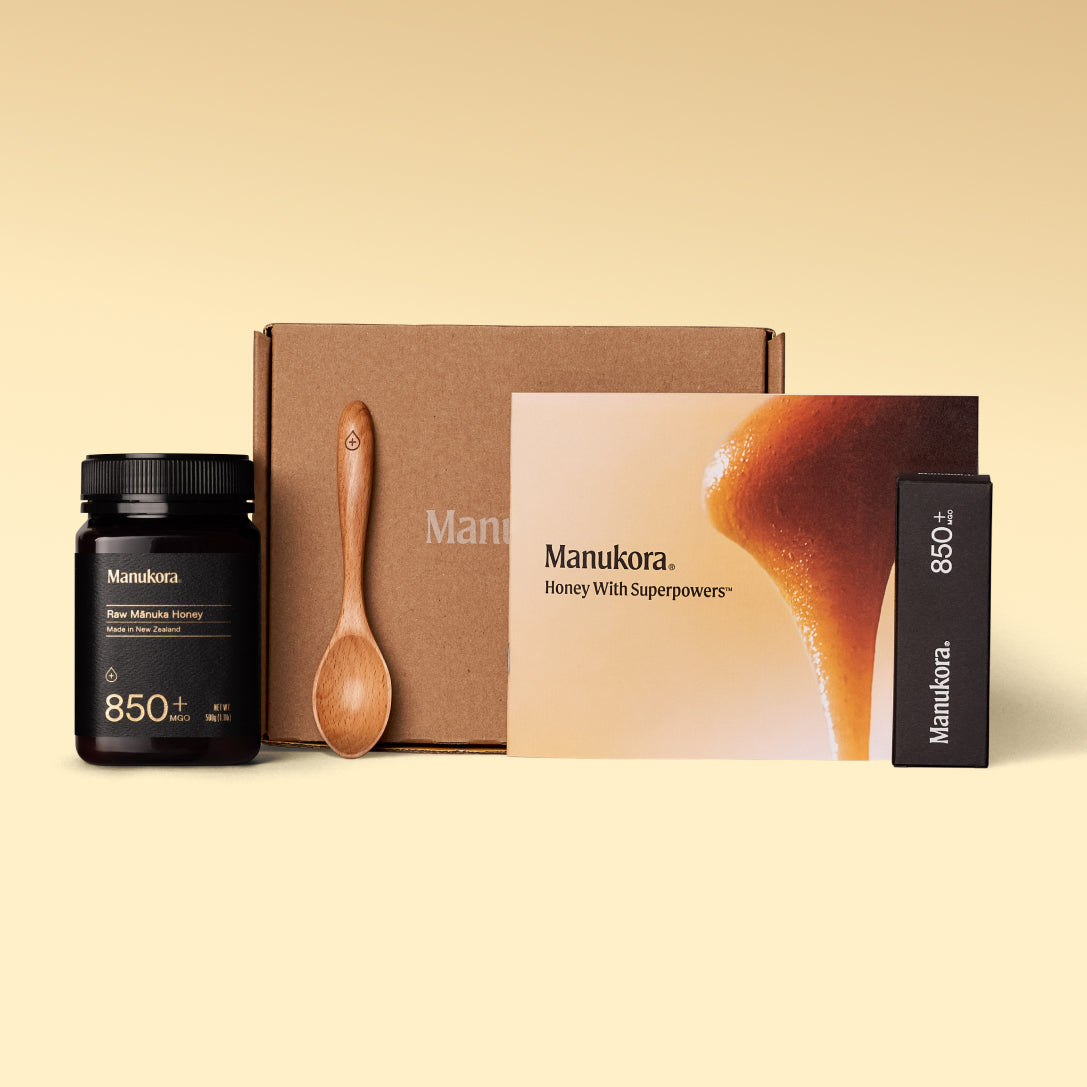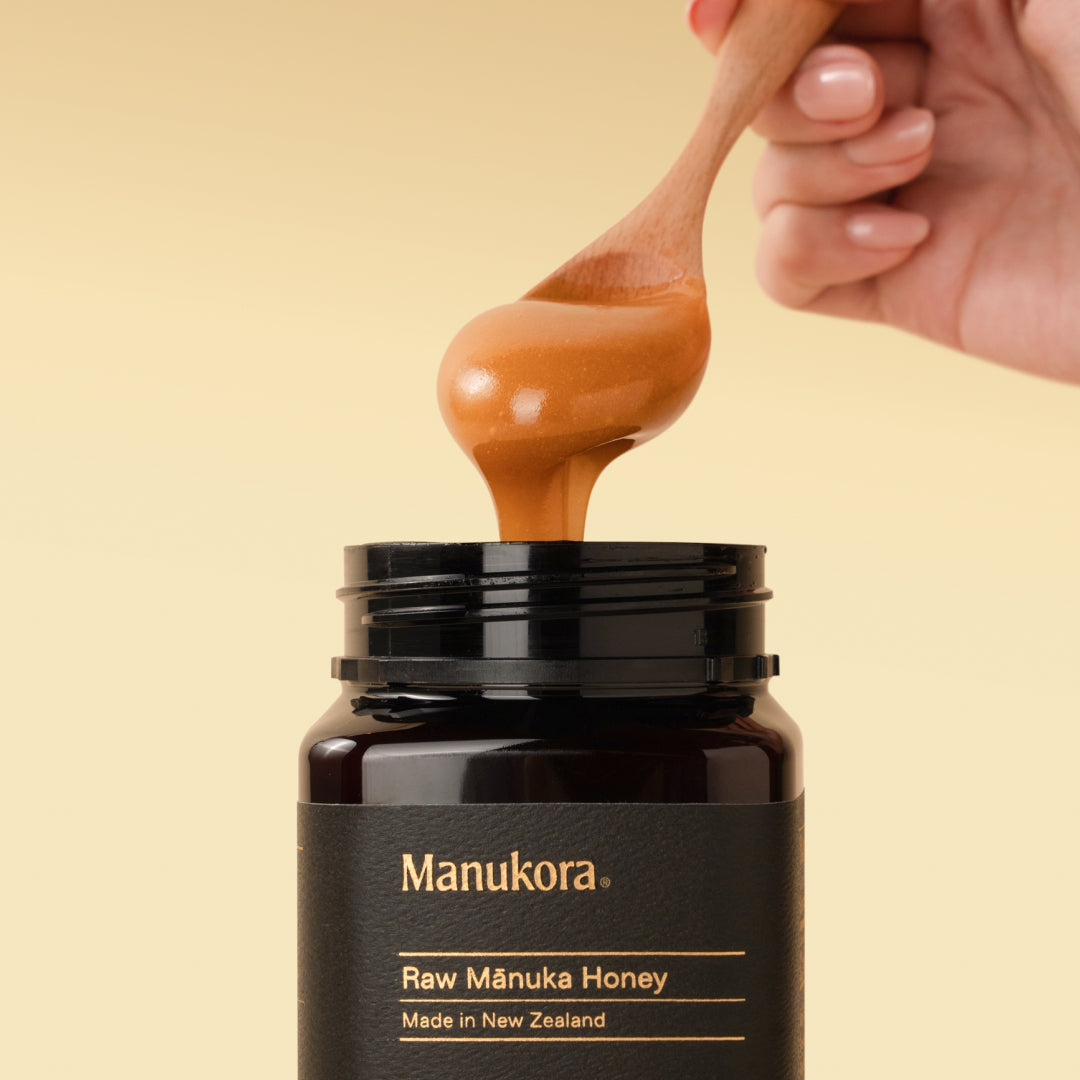Executive Summary:
- Honey gets its color from the plants and flowers the bees consume, and can range from colorless to dark amber.
- The color of honey is measured on the Pfund scale, in which the color is compared to amber glass.
- Dark honey tends to be more potent, have a lower moisture content, and have a unique flavor.
|
Feature |
Dark Honey |
Light Honey |
|
Color |
Dark Amber to Brown |
Water White to Light Amber |
|
Flavor Profile |
Strong, robust, sometimes earthy |
Milder, sweeter, floral |
|
Nutrient Content |
Higher antioxidants, vitamins, minerals |
Less concentrated nutrients |
|
Main Uses |
Wellness support, gourmet cooking |
Daily use, sweetening beverages |
|
Special Compounds |
Unique antioxidants and prebiotics, MGO (Manuka Honey) |
Fewer specialty compounds |
The Differences Between Dark Honey vs. Light Honey
You may wonder what distinguishes light and dark honey. The primary distinctions lie in their color, taste, and nutritional content.
- Color: The color of honey ranges from nearly colorless to dark brown. This variation is primarily due to the floral sources the bees forage on. Lighter flowers, like clover, produce light honey, while darker flowers, such as those from chestnut or buckwheat plants, result in dark honey.
- Taste: Dark honey tends to have a stronger, more robust flavor, often described as bold or earthy. In contrast, light honey usually has a milder, sweeter taste with delicate floral notes.
- Nutritional Content: Dark honey generally contains more unique antioxidants and beneficial nutrients than light honey. This makes dark honey a great choice for supporting overall wellness.
In this article, you'll discover everything you need to know about the differences between dark and light honey, from their production processes to their unique characteristics and benefits.
How Does Honey Get Its Color?
There are hundreds of honey types with a range of colors, textures, and tastes. When it comes to color, different kinds of honey can range in hue from nearly clear and colorless to dark brown.
The color of honey depends on the specific flowers honeybees forage on—lighter flowers produce lighter honey, while darker flowers result in darker honey. For example, flowers such as clover produce lighter honey, while flowers like those from chestnut trees make darker honey.
How Is Honey Color Measured?
The Pfund scale is a standardized way of grading honey color.
A honey sample is placed in a wedge of glass and is then compared to a wedge of amber glass. The reading is the distance (in millimeters) the wedge with the honey travels to find its color match.
What are the different honey colors according to the Pfund scale?
- Water white: 0 mm to 8 mm
- Extra white: 9 mm to 17 mm
- White: 18 mm to 34 mm
- Extra light amber: 35 mm to 50 mm
- Light amber: 51 mm to 85 mm
- Amber: 86 mm to 114 mm
- Dark amber: 115 mm to 140 mm
What Is Dark Honey?
Dark honey typically falls under the “dark amber” category of the Pfund scale. It is dark amber to brown in color and tends to be richer and thicker in texture than its lighter counterparts. Dark honey also tends to have a stronger, more robust flavor than light honey's milder taste.
Dark honey, characterized by its dark amber color on the Pfund scale, is not only richer in flavor but also contains unique nutrients, making it an excellent choice for those seeking wellness support.
Here are some popular dark honey varieties:
- Avocado honey: Made from the blossoms of avocado trees, this honey has a rich, buttery taste and molasses-like texture. It's great for using as a molasses substitute in baking and pairs well with strong cheeses.
- Buckwheat honey: Buckwheat flowers make this honey ultra-dark with a strong flavor and lasting aftertaste. It's often used in gourmet recipes for its unique taste.
- Chestnut honey: This almost-brown honey is known for its mildly sweet, unique flavor. It's often used in gourmet cooking and baking.
- Coffee honey: With its dark amber coloring and coffee-tinged flavor, this honey is a favorite for coffee lovers as a sweetener. It also pairs excellently with desserts.
- Heather honey: Made in Scotland and Greece, heather honey has a dark amber color and a slightly bitter taste. Many like to pair it with a good whiskey.
- Manuka honey: Native to New Zealand, this rare honey is made from the nectar of Manuka tea tree flowers. The high concentration of unique antioxidants and beneficial nutrients gives Manuka its dark coloring. With a dark, creamy texture and a bold flavor profile with hints of toffee and caramel, enjoying Manuka honey is a one-of-a-kind sensory experience.
What Are the Benefits of Dark Honey?
Studies have shown that dark honey contains a higher concentration of unique antioxidants than light honey.
Research from the University of Illinois found that buckwheat honey contains more antioxidants compared to some lighter honeys.
And that’s not all. Darker honey also typically contains more beneficial nutrients like essential vitamins, minerals, and prebiotics.
For example, Manuka honey is known for containing methylglyoxal (MGO), a naturally occurring compound that contributes to its unique properties. Manuka honey also has high concentrations of Leptosperin, which provides high antioxidant properties. All of these unique nutrients are thanks to the characteristics of the Manuka tea tree.
What Is Light Honey?
Light honey generally falls under the “water white” to “light amber” categories on the Pfund scale. It is lighter in color and has a milder, sweeter taste compared to dark honey.
Here are some popular light honey varieties:
- Orange Blossom honey: Made from the nectar of orange tree blossoms, this honey is light amber and sweet, floral. It's versatile and perfect for sweetening teas, desserts, and savory dishes.
- Wildflower honey: This honey comes from the nectar of various wildflowers and can vary in color. It has a mild, floral flavor and is excellent for general use, including baking and as a spread.
- Sage honey: This light, delicate, herbal honey is made from the nectar of sage plants. It's a rare treat due to the specific weather conditions needed for its production and is ideal for gourmet cooking.
- Clover honey: Known for its mild, sweet taste, clover honey is excellent for daily use, such as sweetening beverages and cooking.
Light honey offers a milder taste and lighter color, ideal for those who prefer a gentle sweetness in their daily beverages and culinary preparations.
Comparing Dark and Light Honey: Key Differences
- Color: Dark honey is darker in color than light honey, qualifying as “dark amber” on the Pfund color scale.
- Taste: Dark honey has a stronger flavor and a thicker, creamier texture. It offers a bold taste experience compared to light honey's sweeter, milder flavor.
- Nutrient Content: Dark honey often contains higher levels of unique antioxidants and beneficial nutrients compared to light honey.
- Water Content: Dark honey tends to have a lower water content than lighter honey, meaning it’s often more concentrated.
Many honey manufacturers harvest honey before the bees have had a chance to dehydrate it naturally. When this process is used, the honey must be artificially dehydrated (heated) to remove moisture, which can reduce its beneficial nutrients.
At Manukora, we believe in letting the bees finish their natural process. We don’t harvest the honey until the bees have had a chance to properly cure and dehydrate it, allowing it to retain its incredible properties. By working with nature, we aim to have a positive impact on the environment and produce exceptional honey!
The robust profile of dark honey is complemented by its lower moisture content, enhancing its flavor and nutritional density compared to lighter honey.
Recap: Dark Honey vs. Light Honey – Which One to Choose?
Honey can have a variety of colors, textures, and tastes depending on the specific flowers honey bees use to make it. Dark honey is rated “dark amber” on the Pfund color scale, and it’s typically darker in color and bolder in taste than light honey.
Dark honey also often has a higher nutrient profile, like the MGO found in Manuka honey.
So, which is better? That depends on individual tastes and what you plan to use the honey for. Light honey might make sense if you’re simply looking for a sweetener for your daily tea.
Yet, if you’re looking to support your overall wellness, it’s hard to beat the dark deliciousness and unique nutrients that raw Manuka honey provides!
The range of Manuka honey available at Manukora's collection can be a delightful start. Their high-grade Manuka Honey MGO 600+, MGO 850+, and MGO 1000+ are particularly noteworthy for their exceptional quality.
Additionally, health-conscious individuals might find their trending products section interesting, offering a variety of choices for different needs. For enthusiasts keen on understanding the honey-making process, Manukora’s informative blogs are invaluable resources.
Ready to experience Manuka honey for yourself? Explore our best-selling Manuka honey starter kits, available in MGO 600+, 850+, and 1000+, to find the perfect addition to your wellness routine.
FAQs
Why is some honey darker than others?
The color of honey is influenced by the types of flowers and plants the bees consume. Some flowers, like clover, produce lighter honey, while others like chestnut trees create darker honey.
How is the color of honey measured?
The color of honey is measured using the Pfund scale. The honey sample is compared to a wedge of amber glass, and the color match is found by measuring the distance (in millimeters) the wedge with the honey travels.
What are the benefits of dark honey?
Dark honey is rich in unique antioxidants, beneficial nutrients, vitamins, and minerals. For instance, Manuka honey, a type of dark honey, contains methylglyoxal (MGO), a naturally occurring compound that contributes to its unique properties.
What are the main differences between dark honey and light honey?
Dark honey is usually richer in taste and texture and often has higher concentrations of beneficial nutrients compared to light honey. It also tends to have a lower water content, making it more concentrated per ounce.
Sources:
United States Standards for Grades of Extracted Honey | USDA
Types of honey by flower source and flavor; and where to get them | Local Honey Finder
Dark Honey Has More Illness-Fighting Agents Than Light Honey | ScienceDaily
Dynamics of the Cellular Metabolism of Leptosperin Found in Manuka Honey | PMC


















